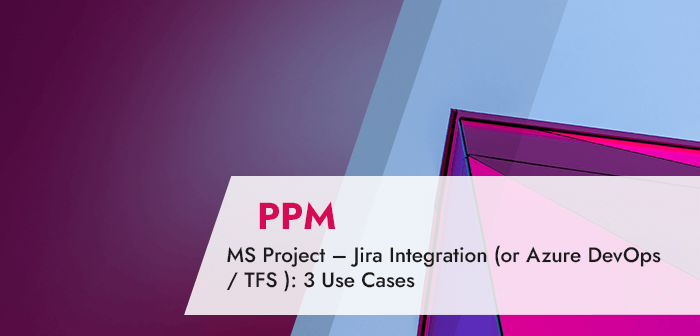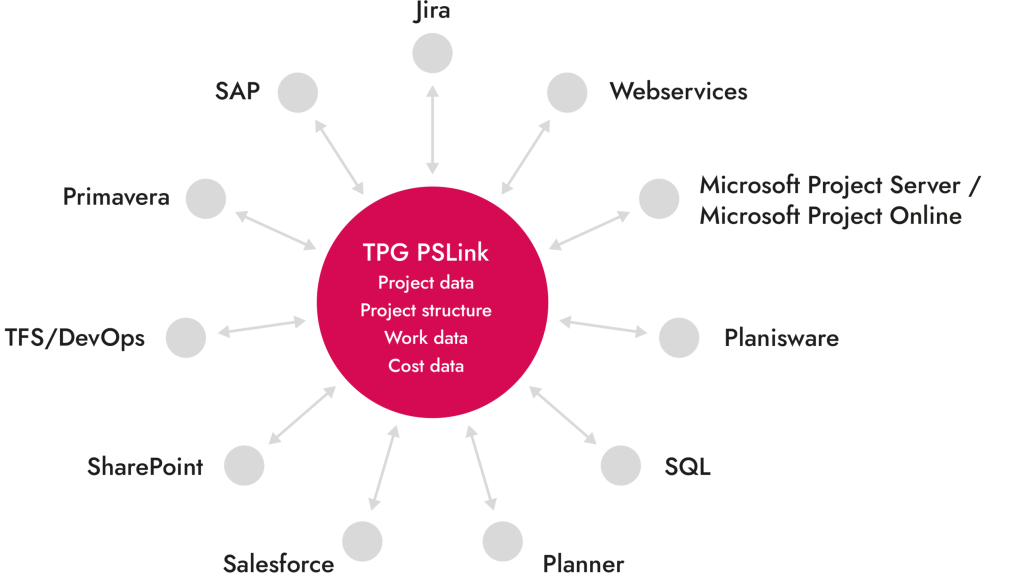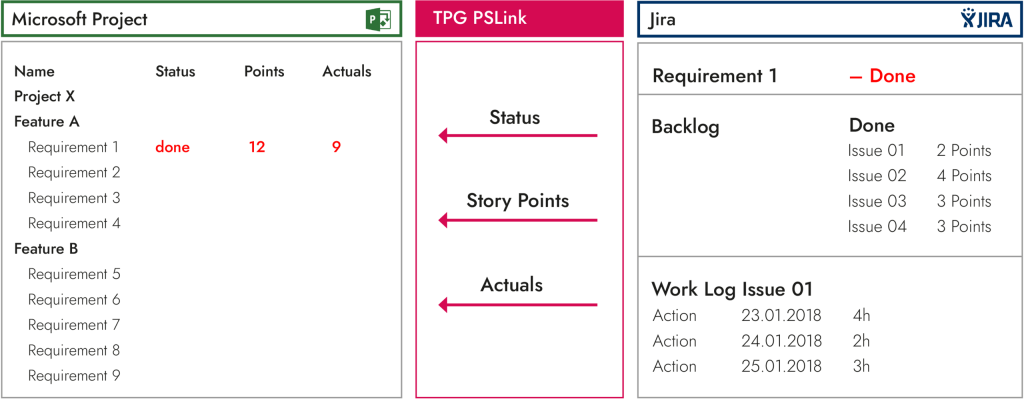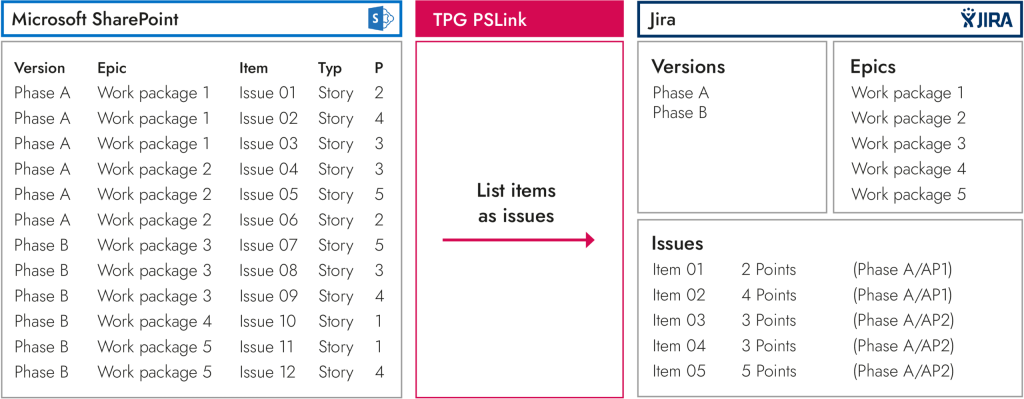If you are working with Microsoft Project Server / Project Online (PPM), you will already know this. It is a tool for project managers, optimized to plan projects with tasks and work packages in a structured way. But it does not lend itself well to the detailed depiction of many little and personal jobs below tasks. Tools such as Atlassian Jira or Microsoft Azure DevOps Server (former TFS) are much better suited for this. With these tools, detailed issues can also be planned in sprints and iterations. In this article you will learn more about:
- General Benefits of an Integration
- Business Use Case 1: Microsoft Project-Jira Integration
- Business Use Case 2: Integration of Jira with SAP
- Business Use Case 3: Integration of Jira, SAP, SharePoint, Project Server / Project Online
- Conclusion – MS Project-Jira Integration or Azure DevOps / TFS Integration
Learn about the advantages of the central Microsoft PPM over Microsoft Project Standard.
So how can the two worlds be linked up again? And what are the advantages of an integration such as the MS Project-Jira integration?
Using 3 classic business cases, this article aims to show what you gain by integrating project and work management.
Please note: The business cases presented here can only be realized with Microsoft Project Server or Project Online (PPM). Moreover, the business cases use the interface product TPG PSLink. It permits the realization of different scenarios. In these scenarios, either the user triggers the data exchange; or automated jobs run in the background.
General Benefits of an Integration
The cross-system data exchange between MS Project and Jira or Azure DevOps / TFS will provide the following benefits for all roles involved:
- Each role works with the system that is best for them
- Efficient provision of current information for all involved
- Reliable data as the best possible basis for work and decision-making
- Reduced effort and duration for planning and updating
- Multiple data entry is avoided
- Data consistency is ensured in all systems involved
MS Project-Jira integration is an example of hybrid project management. Find out more.
The ROI of your integration increases with the:
- Number of integrated systems
- Amount of data
- Number of persons involved
- Number of updates
Thinking about introducing a Project & Portfolio Management (PPM) solution? Read about 3 Approaches to the Task.
The following use cases are described using the example of the integration of MS Project with Jira. It is also very similar with Azure DevOps / TFS.
Business Use Case 1: Microsoft Project-Jira Integration
A: Transferring the Structure from MS Project to Jira
Each project manager requires a project structure providing optimal support for project control. It can differ depending on the type of project. IT, service, organizational, or development projects do not have the same structures.
Therefore, you should ask yourself the same question for each business case. How to assign the many small issues from Jira to the tasks / work packages in the Microsoft Project plan?
Struggling with Program Management? Read these 8 Tips to Increase Success.
A 1:1 link only makes sense at the structural level into which the aggregated values of the detailed issues are synchronized with Microsoft Project.
There is a prerequisite for the automatic integration. On a task in MS Project, there needs to be a clear assignment of a Jira object to which in turn issues are assigned.
The customer requirement we encounter most often is the connection of projects to versions and epics. As a rule, phases of the MS Project plan are represented as versions and work packages as epics. Issues are assigned to the epics in this case.
Special Download: Advantages of MS Project Server / Project Online over MS Project Standard
Please click here to download the PDF and learn why you should prefer the server over the client version.
Further possibilities of structural alignment can be:
- Tasks in MS Project correspond to sprints in Jira: The aggregated values of issues in the sprints are synchronized with tasks the in MS Project.
- Component-oriented plan in MS Project: The aggregated values of issues assigned to the components are synchronized with the tasks in MS Project.
In the case of changes to the project plan, these need to be transferred to Jira, too. This applies to the structure as well as the dates and other additional information.
B: Automated Population of Issues in Jira
With standard projects, reverting to standardized issues can be useful in issue management. You should not have to enter these again each time. Ideally, they could be imported.
SharePoint is an excellent tool for providing a list of issues per project type in a simple way. For new projects, a suitable integration tool will allow you to carry this list over to Jira at the push of a button. This will save you a lot of time.
C: Reporting the Progress from Jira to PPM
As part of project control, the project manager needs to be informed on the progress of all deliverables at regular intervals.
He or she needs to know both the progress with regard to content and the efforts recorded. Jira can provide both automatically when maintained properly.
This requires the team members to maintain e.g. story points on the one hand to illustrate the performance with regard to content. When closing issues, these story points are transferred back to the corresponding structure of the MS Project plan.
You might also be interested in: 7 Crucial Success Factors for Multi-Project Management
On the other hand, the team members enter the hours worked per issue. The result can also be transferred back to MS Project.
Of course, you can also synchronize the status of objects at the structural level. You transfer the status of the corresponding objects in Jira back to MS Project.
The figure below shows you the:
- sum of the story points of the hitherto completed issues
- corresponding effort
- status of the higher-level epic
Interested in using Jira? Read our tips for:
Business Use Case 2: Integration of Jira with SAP
If portfolio and project management is carried out in an ERP system such as SAP, the integration scenario will be similar to that described in business Use Case 1 above. In other words, the rough planning is done in SAP PS or PPM, while Jira is used for detailed planning and the execution of the work packages. A further important point here is timesheet synchronization. In this process, the work logs (timesheets) are transferred from Jira to SAP CATS or to SAP for cost allocation.
Business Use Case 3: Integration of Jira, SAP, SharePoint, Project Server / Project Online
This business use case scenario is the one most frequently found in larger enterprises. It enables companies to better manage their multi-project and program environments, and integrates several different areas: finance, project management, and detailed task management planning. The integration commonly encompasses the following systems:
- SAP: for budget planning and cost allocation
- Microsoft Project Server and SharePoint: for portfolio and project management as well as for centralized time tracking
- Jira: for sprint planning, task management, issue tracking, workflow management, and status monitoring
The integration enables the following data sharing processes between the individual systems:
- SAP <> Microsoft PPM / SharePoint: structures, costs, budgets
- Microsoft PPM / SharePoint <> Jira: work packages to versions / epics / issues
- SAP <> Microsoft PPM <> Jira: booking of Jira work logs and Microsoft Project reports to SAP CATS or to SAP for cost allocation
Conclusion – MS Project-Jira Integration or Azure DevOps / TFS Integration
This article has introduced you to three important integration business use cases of PPM, ERP systems with Jira / Azure DevOps / TFS. Each of them would allow you to exchange data between Microsoft Project and Jira as well as SharePoint. Or to display data from one system in the other. The cases concern the:
- Transfer of the structure from Microsoft Project to Jira
- Automated population of issues in Jira
- Reporting the progress from Jira to MS Project
- Displaying issues in MS Project – without import
One Last Recommendation: There are cheap and established solutions only able to connect MS Project and Jira. But most companies intend to do more than this integration. For them, it is a matter of connecting as many systems as possible in a meaningful way as part of digital transformation. Therefore, it makes sense to use middleware integrating and controlling many systems centrally. Other interesting systems could be ERP or CRM systems as well as further databases.
Do you have experience with integrated project and task management systems, such as MS Project-Jira integration? How has the integration changed the way you work? Is there anything you would like to add? Please leave a comment below!










2 Comments
I have worked with JIRA and MS project extensively and have found the best integration is to use MS Project to manage the larger milestones of a sprint such as the Sprint Start, Backlog Grooming Meetings, Demonstrations, and Sprint End, etc. Involving MS Project at the story level is too much information that is more aptly handled in JIRA. A very important consideration is that JIRA is based on Agile and MS Project is set up for waterfall so handling the waterfall aspects of the project are rightly done in MS Project, best to leave the Agile stuff to JIRA. MS Project is also a valuable tool when handling multiple SW development projects, it keeps the scheduling of meetings and transition dates very clear to you and your teams.
Thanks for the valuable comment. The integration of the two systems is important for precisely this reason: the two tools with their respective strengths need to be combined. More detail here.